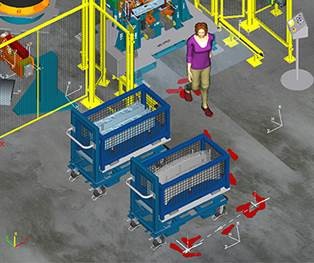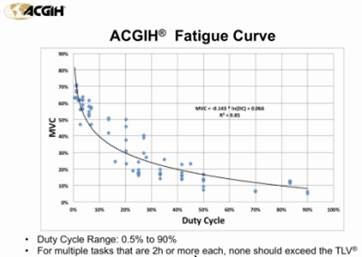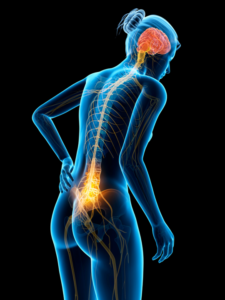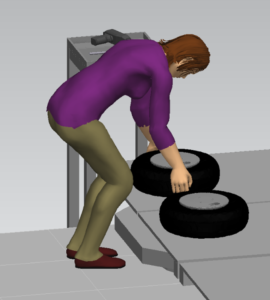
There are many tools used by ergonomic professionals to quantify the risk to employee health associated with a task. But an issue with many of these tools is exactly that; they quantify risk associated with “a task” and not multiple tasks. Traditionally, each task is assessed separately and the risk level for each task is deemed acceptable or unacceptable based on industry standards. This barrier has existed in the science of ergonomics for as long as ergonomics has been practiced. That is, the tools used are very effective in assessing risk of singular tasks, at varying levels of repetition, but do not consider combined effects of variable tasks. Of course, for the majority of the working population, most jobs we perform are variable in nature.
For instance, if an ergonomist was evaluating a task of picking up a box and moving it from the floor to a cart, they could use the NIOSH Lifting Equation to determine the level of risk for lifting the box off of the floor and placing it on the cart. They could then use the Liberty Mutual tables to assess the risk associated with carrying the box the required distance. Both assessments would incorporate the repetition rate of the task.
But, the lift and carry components of the task are assessed in isolation from one another, meaning that the lifting risk assessment results would remain the same even if the carry was eliminated. A cumulative or combined effect of one task – carrying, on another task – lifting, is not considered even though many of the same muscle and joint groups are used to perform both tasks.
Fortunately, advances in the science of ergonomics have led to the development of tools that are able to assess combined risk with task variability. For instance, the NIOSH Composite Lifting Index (CLI), and more recently the Cumulative Lifting Index (CULI), allow for multiple lifts, with different lifting parameters, to be evaluated together. Thus a cumulative risk of all of the lifting that a warehouse worker does could be evaluated. Unfortunately, the ability of these tools stops there. They still cannot include other task types, such as carrying or pushing a cart that the same warehouse worker might be required to do.
In the attempt to overcome this long standing barrier, the concept of fatigue based evaluation has led to the development of additional tools. Tools with the ability to combine any number of tasks, with variable task types, and evaluate a complete picture of a person’s duties.
One strategy is using the Garg method for assessing central fatigue through estimation of metabolic demand, or calories burned. Wherein the energy cost is determined for each task that a person completes and the sum of all task energy costs is determined in the form of a metabolic rate (calories per minute). This is then evaluated against an industry standard for risk of undue fatigue characterized by decreased motor control and/or exhaustion.
Although, when it comes to Repetitive Strain Injuries (RSIs), central fatigue isn’t likely to be the major factor. More likely, peripheral fatigue of a specific joint or muscle group will develop and lead to the RSI. New research in ergonomics is focused on this concept, and evaluating the cumulative fatigue from all tasks for any region of the body.
Specifically, peripheral fatigue Threshold Limit Value (TLV) curves for the upper extremity have been developed by Dr. Potvin and the ACGIH. These provide a way of assessing all types of tasks across the hand and wrist joints as well as the elbow joint. Using the concepts of duty cycle and percent of strength (or %MVC), this curve equation can be used with any population specific strength database to determine maximum acceptable efforts, maximum allowable duty cycle, and required recovery time.

Furthermore, advances in technologies associated with motion capture and digital human modelling are allowing new data to be gathered. This consists of continuous collection of spine compression and shear forces as well as all activity of any other muscle groups elected. This can also be done across long periods of time and with complex tasks. The future collection and analysis of these comprehensive data sets is paramount for developing further models and resultant standards for cumulative loading of all body regions.
There are still gaps in our knowledge that prevent us from understanding fully, all of the risks associated with RSI, but it should be comforting that the science of ergonomics is advancing and steadily closing those gaps.








 Why Sandalwood?
Why Sandalwood?


 We are a one-stop-shop for launching job rotation for any employer from conception to implementation. Our experts tailor our services to meet the needs of our customers by collaborating with them throughout the entire process. We do not offer cookie cutter solutions for job rotation because the needs of employers vary significantly.
We are a one-stop-shop for launching job rotation for any employer from conception to implementation. Our experts tailor our services to meet the needs of our customers by collaborating with them throughout the entire process. We do not offer cookie cutter solutions for job rotation because the needs of employers vary significantly. Why Sandalwood?
Why Sandalwood?



 Sandalwood is pleased to offer solutions above and beyond the traditional ergonomic assessments. With an in-depth knowledge of various digital human modelling software suites, integration and adoption to your health and safety programs has never been easier. Sandalwood is experienced in ergonomic program design as well as industry leaders in digital human modelling services. We have a diverse team that is able the leverage the results from the digital human model to provide in depth risk assessments of future designs and current state. Sandalwood is also able to pair these assessments with expertise and provide guidance on the best solution for you. Sandalwood is also on the forefront of emerging technologies and able to integrate Motion capture, Wearables, and extended or virtual reality into your ergonomic program.
Sandalwood is pleased to offer solutions above and beyond the traditional ergonomic assessments. With an in-depth knowledge of various digital human modelling software suites, integration and adoption to your health and safety programs has never been easier. Sandalwood is experienced in ergonomic program design as well as industry leaders in digital human modelling services. We have a diverse team that is able the leverage the results from the digital human model to provide in depth risk assessments of future designs and current state. Sandalwood is also able to pair these assessments with expertise and provide guidance on the best solution for you. Sandalwood is also on the forefront of emerging technologies and able to integrate Motion capture, Wearables, and extended or virtual reality into your ergonomic program.



